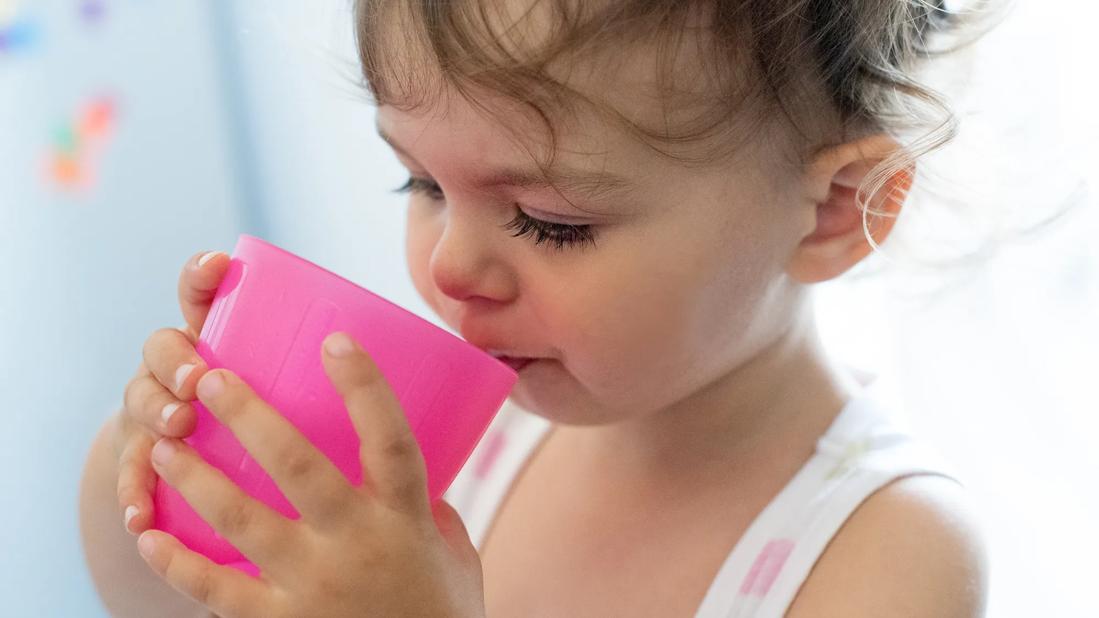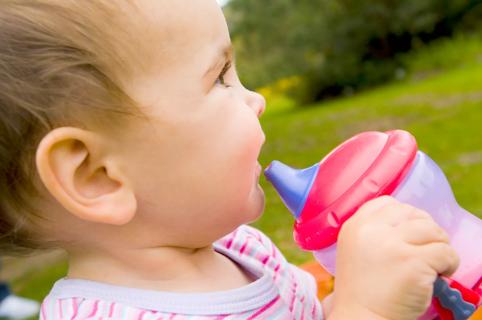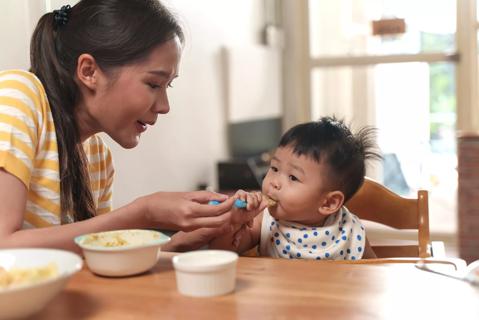Ideally, you want your toddler to be drinking from a ‘big kid cup’ by age 2

Sippy cups. Trainer cups. Bottles. Whatever you choose to use to feed your baby, the transition to regular, adult-sized cups can be a challenge. Some little ones are totally game, while others greet the prospect of ‘big kid cups’ with huffs, puffs and temper tantrums. And who can blame them? They’re just getting a handle on the whole “being alive” thing. And now you’re changing the routine!
Advertisement
Cleveland Clinic is a non-profit academic medical center. Advertising on our site helps support our mission. We do not endorse non-Cleveland Clinic products or services. Policy
But change they must. When it comes time to buck the bottle — or send the sippy cup packing — pediatrician Jason Sherman, DO, suggests a few ways to go about it.
There’s no golden rule, but the American Academy of Pediatrics (AAP) recommends that you start weaning your baby off of their bottle at around six months. The goal is to reduce bottle feedings slowly and complete the transition to a sippy cup by the time your little one is 12 months old.
“At around 12 months, kids start becoming emotionally attached to their bottles,” Dr. Sherman notes.
OK, so we’ve reached the sippy cup phase. Now what?
Think of sippy cups as a bridge to the open cup. You don’t want your wee one to linger in this stage. Ideally, you want your toddler to graduate to the real thing before they hit age 2.
“The longer you wait to wean your child off the bottle or sippy cup, the harder it’ll be,” Dr. Sherman says. It can also raise the risk of certain health conditions. More on that in a bit.
Before we move on, it’s important to note that these guidelines assume that your baby is healthy and developing typically. But all kiddies are different. And that’s OK. If your child has a medical condition or you have any concerns about their growth, consult with their pediatrician.
Advertisement
The process of weaning your child off bottles and sippy cups can be a bit nerve-wracking (and loud!) at first. But your time and patience will eventually pay off.
Dr. Sherman shares some tips that may make the transition a bit smoother. Keep the ones that work and leave the ones that don’t!
Dr. Sherman advises giving your baby a sippy cup with a few ounces of water during one meal of the day, starting at around 6 months of age, when babies start eating solids. They don’t need water at 6 months, and should only have a little each day. It’s more about minimizing mess.
“In the (very likely) event that your little pitcher ends up throwing the sippy cup, it won’t be difficult to clean, since it’s only water,” he offers.
Switching to a cup is a motor development tool, meaning it helps train children to use cups correctly. Dr. Sherman recommends putting all of your child’s milk or formula into cups at 10.5 to 11 months. That should give them the time they need to be off bottles completely before their first birthday.
Speaking of water, what you’re putting in baby’s cup is just as important as their using it.
In the lead-up to baby’s first birthday, you should only be giving them breast milk, formula and a couple ounces of water. Dr. Sherman says you can give them a few ounces of juice as needed to address constipation.
Once your kiddo’s a year old, you can introduce cow’s milk, plant-based milks, decaffeinated herbal teas, and homemade fruit and vegetable smoothies into their diet. Water’s still the best choice because it’s calorie-free, sugar-free and — if you live in a country with fluoridated water — can help prevent tooth decay.
Speaking of tooth decay, Dr. Sherman says that while it’s OK to give your wee one four to six ounces of fruit juice a day after they turn 1, it’s best to avoid beverages that are carbonated or full of added sugars.
To help with the initial transition, Dr. Sherman says you can tell your child they can only have their bottle and sippy cups at meals and at bedtime (but not in bed). Otherwise, they have to start using a cup.
“Start by gradually dropping their sippy cups and bottles from the feeding schedule,” he recommends. “If they have them three times a day, try giving it to them twice a day, instead.”
“You can also stop cold turkey,” suggests Dr. Sherman. “Tell your child that they’re big now and it’s time to give those sippy cups and bottles to someone else who needs them.” In order to do that (without risking dehydration), you have to have already spent a good while introducing them to open cups.
Advertisement
As you might imagine, results vary with the cold turkey approach. Yes, it’s the fastest way to transition your child to big kid cups, but it can be upsetting for parent and child alike.
What you can’t do is start them off cold turkey and then reintroduce the bottle or sippy cup whenever they get too fussy. You don’t want your wee one learning that they’ll be rewarded for throwing a fit.
Making milestones like graduation to open cups happen takes a lot of willpower on parents’ parts. And it’s never harder than it is in the moments when your wee-one’s screaming their tiny lungs out.
Dr. Sherman recommends figuring out if your child is hungry or thirsty before giving in to the bottle. Do they want cuddles, comfort or attention instead? They may be reaching for the bottle or sippy cup for comfort when, in reality, they want something else.
Dr. Sherman recommends busting out the confetti and party hats when your toddler takes successful sips from their big kid cup. “Turn it into a celebration or a ceremony so your child can feel good about moving on,” he says.
Once you successfully weaned your child off bottles and sippy cups (or once you’re in the process), it’s important to supervise your child with adult-sized cups.
Advertisement
“If you are worried about the mess with using regular cups, supervision is critical and helps keep the cups in the kitchen,” advises Dr. Sherman. “Ground rules will help you contain a mess as your child learns a new, important skill.”
Have you ever stopped to think about all the different vessels we call “cups”?There’s a lot of them. But which is the best for transitioning away from the bottle or sippy cup?
It may seem a bit counterintuitive, but experts recommend you start with an open training cup. You may even want to skip the sippy cup phase altogether.
“Sippy cups are a relatively recent invention, so kids previously just used regular cups,” shares Dr. Sherman. “Consider starting with a plastic or silicone cup with no lid. There’s no question that a 1-year-old can start to use a cup with two hands.”
To be clear, when we talk about an open plastic or silicone cup, we’re not talking about the spill-proof kind — the experts want you to give baby the real deal! Spill-proof cups may be more convenient and make less mess, but they can also promote unhealthy drinking patterns, like jaw protrusion and unusual tongue placement.
Once baby’s comfortable using an open cup, then you can integrate cups with straws. They’re a more portable option but they may take some getting used to.
Advertisement
Right about now, you might be thinking, “Why does it matter when we transition our kid to adult cups? Isn’t two years an arbitrary guideline?”
Like most milestones, you can give or take a month or two without worrying too much about baby’s progress. But that doesn’t mean the 2-year guideline is random or unimportant. As Dr. Sherman explains, letting baby drink from a bottle or sippy cup for too long can have unintended consequences.
Change is tough. And bottles and sippy cups aren’t just vessels for feeding. They, like pacifiers, also have a soothing effect on baby. And they’ll get more and more attached to (and dependent on) them with time.
“The longer you wait to wean your child off the bottle or sippy cup, the harder it’ll be,” Dr. Sherman warns.
Baby bottle tooth decay happens when your child drinks from a bottle for too long, causing the sugar from the milk or juice to sit on your child’s teeth. That sugar, Dr. Sherman explains, eventually leads to cavities and decay.
“I completely understand getting rid of the bottles isn’t always fun for anyone involved,” he concedes. “But it beats the alternative, which is having a dentist put your child under anesthesia (since they can’t sit still) to fix cavities. It’s also way less expensive.”
If your baby’s allowed to drink from a bottle throughout the day while also having solid food at mealtimes, you’ll be confronted with one of two scenarios (or both, at different times):
Changing a child’s routine is hard. Really hard. It’s time consuming and thankless. And sometimes, things aren’t going to go according to plan. Open cup rejection and regressions happen. Babies miss milestones. And NONE OF THAT is an indictment of your parenting skills.
It’s no small ask — but try to give yourself some grace. If you’re making every attempt to keep your toddler on track (and off bottles and sippy cups), you’re doing what’s best for them. And that means you’re doing a good job.
If all that effort isn’t yielding results, try not to shame or blame yourself. Consult your pediatrician. They’re here to help. If they aren’t helping, request a referral to an infant-feeding specialist, a pediatric development specialist or a pediatric dietitian. Dr. Sherman says occupational and speech therapists can be helpful too, as they perform oral motor function assessments. Baby doesn’t have to go through this transition alone. And neither do you.
Learn more about our editorial process.
Advertisement

In babies under 12 months old, cow’s milk has been associated with gastrointestinal bleeding

No juice until your child is 1 year old — and even then, they shouldn’t have much, if any

Ultimately, the choice depends on what works best for you and your baby, but it’s also important to be aware of the pros and cons of both

Letting your baby feed themself foods the whole family enjoys has its benefits — but stick to softer foods and follow safe-eating guidelines

Levels are generally low, but there are ways to minimize potential health risks

Slowly introducing cow’s milk (or soy milk) can help your child make the change

In babies under 12 months, honey may cause a serious illness called infant botulism

A daily dose of vitamin D can help babies build strong bones, as well as boost their brain development

Start having sex about 72 hours before ovulation, then at least every other day during your fertile window

Attachment theory suggests that your earliest relationships shape connections throughout your life

It isn’t a recognized mental health disorder, but research shows that problematic social media use can negatively affect your mental health, self-esteem and sleep